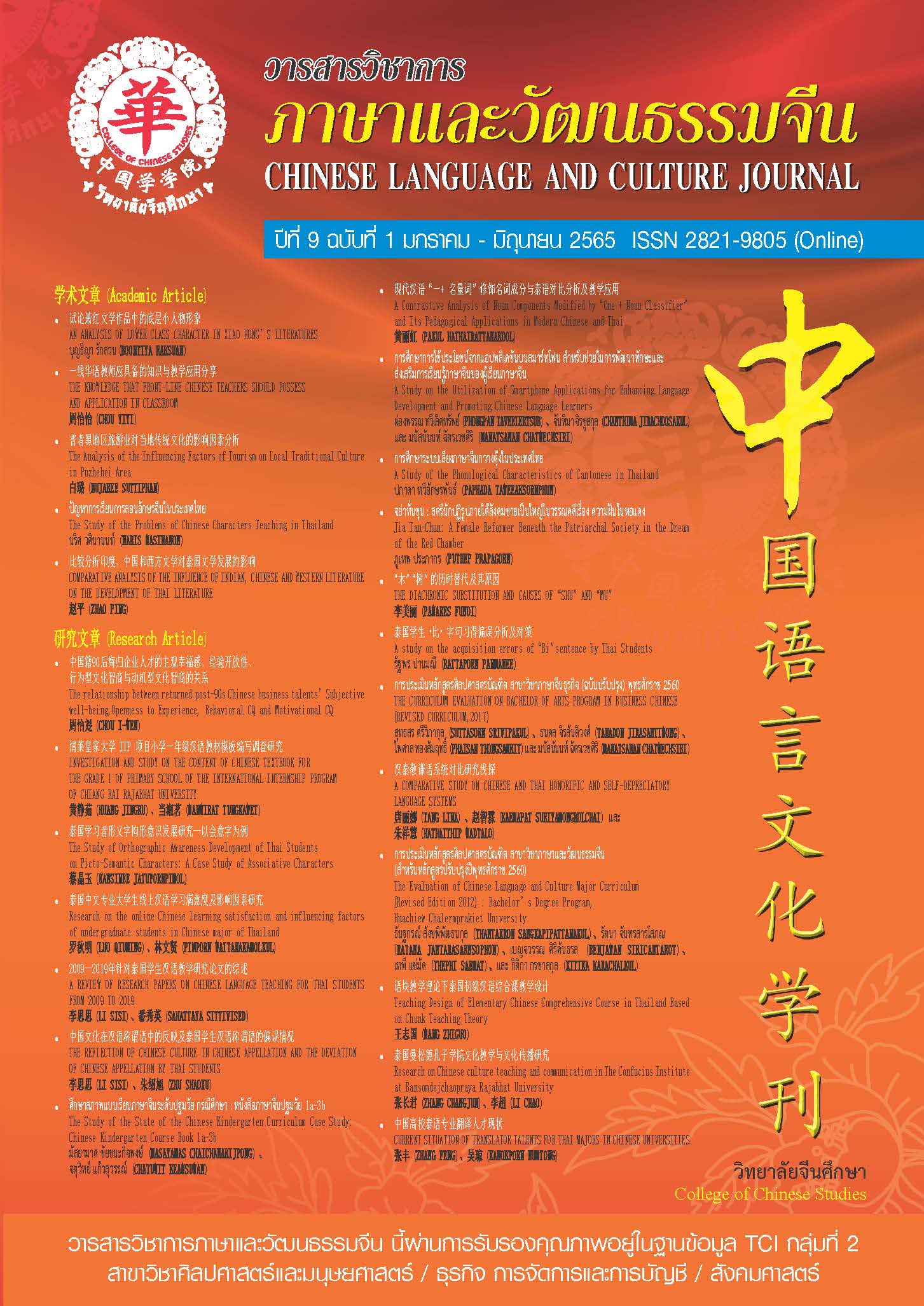一线华语教师应具备的知识与教学应用分享
THE KNOWLEDGE THAT FRONT-LINE CHINESE TEACHERS SHOULD POSSESS AND APPLICATION IN CLASSROOM
Keywords:
Chinese language teaching, teaching theory, cognitive science, teaching applicationAbstract
In recent years, Chinese language teaching has been attracting world attention in the field of foreign languages. Based on the study of English as a foreign or second language, the Chinese language teaching community has also developed teaching models that are appropriate for the Chinese language, and has developed many teaching materials that are specific to the Chinese language. However, in the field of a second language "learning," many researchers have also looked to the "acquisition" of the first language (or native language) to make language learning more efficient. In 1999, Dr. Safrran proposed statistical learning, which has attracted attention in the fields of linguistics, anthropology, and cognitive science, and Saffran has used numerous empirical studies to test the relationship between statistical learning mechanisms in the human brain and language acquisition. In this paper, I not only re-examine the relationship between language acquisition and statistical learning but also propose the application and limitations of statistical learning based on the front-line teaching experience.
References
《中文书目》
王赞育,陈振宇(2015)统计学习机制在语言习得中的角色及其对第二语教学的可能启发。华语文教学研究,12.4:11-44
陈振宇。2013。学语言是学到了什么?从语言的多面向样貌探讨语言教学的新路径。台湾华语教学研究,第7期,1-12。
《英文书目》
Atkinson, D.(Ed).(2011b). Alternative approaches to second language acquisition. New York: Routledge.
Baker, C. I., Olson, C. R., & Behrmann, M. (2004). Role of attention and perceptual grouping in visual statistical learning. Psychological Science, 15(7), 460–466.
Conway, C. M., & Christiansen, M. H. (2005). Modality-constrained statistical learning of tactile, visual, and auditory sequences. Journal of Experimental Psychology. Learning, Memory, and Cognition, 31(1), 24-39.
Dimroth, C. (2018). Beyond statistical learning: Communication principles and language internal factors shape grammar in child and adult beginners learning Polish through controlled exposure. Language Learning, 68(4), 863-905.
Fiser, J. Z., & Aslin, R. N. (2002). Statistical learning of higher-order temporal structure from visual shape sequences. Journal of Experimental Psychology: Learning, Memory, and Cognition, 28(3), 458–467.
Kittleson, M. M., Aguilar, J. M., Tokerud, G. L., Plante, E., & Asbøjrnsen, A. E. (2010). Implicit language learning: Adults' ability to segment words in Norwegian. Bilingualism, 13(4), 513-523.
Lew-Williams, C., Pelucchi, B., & Saffran, J. R. (2011). Isolated words enhance statistical language learning in infancy. Developmental Science, 14(6), 1323–1329.
Misyak, J. B., & Christiansen, M. H. (2012). Statistical learning and language: An individual differences study. Language Learning, 62(1), 302–331.
Newport, E. L., & Aslin, R. N. (2004). Learning at a distance I. Statistical learning of nonadjacent dependencies. Cognitive Psychology, 48, 127–162.
Pelucchi, B., Hay, J. F., & Saffran, J. R. (2009a). Statistical learning in a natural language by 8-month-old infants. Child Development, 80(3), 674–685.
Saffran, J. R., Aslin, R. N., & Newport, E. L. (1996). Statistical learning by 8-month-old infants. Science, 274(5294), 1926–1928.
Saffran, J. R., Newport, E. L., & Aslin, R. N. (1996). Word segmentation: The role of distributional cues. Journal of Memory and Language, 35, 606–621. (adults learning artificial language, TP and prosodic cues)
Saffran, J. R.,Johnson, E. K., Aslin, R. N., & Newport, E. L. (1999). Statistical learning of tone sequences by human infants and adults. Cognition, 70(1), 27-52.
Saffran, J. R., & Wilson, D. P. (2003). From syllables to syntax: Multilevel statistical learning by 12-month-old infants. Infancy, 4(2), 273–284.
Saffran, J. R., Newport, E. L., Aslin, R. N., Tunick, R. A., & Barrueco, S. (1997). Incidental language learning: Listening (and learning) out of the corner of your ear. Psychological Science, 8, 101–105.
Shukla, M., Nespor, M., & Mehler, J. (2007). An interaction between prosody and statistics in the segmentation of fluent speech. Cognitive Psychology, 54(1), 1–32.
Siegelman, N., & Frost, R. (2015). Statistical learning as an individual ability: Theoretical perspectives and empirical evidence. Journal of Memory and Language, 81, 105–120.
Siegelman, N., Bogaerts, L., Christiansen, M. H., & Frost, R. (2017). Towards a theory of individual differences in statistical learning. Philosophical Transactions of the Royal Society of London, Series B, Biological sciences, 372(1711), 20160059.
Slone, L. K., & Johnson, S. P. (2018). When learning goes beyond statistics: Infants represent visual sequences in terms of chunks. Cognition, 178, 92-102.
Thiessen, E. D., & Saffran, J. R. (2003). When cues collide: Use of stress and statistical cues to word boundaries by 7-to 9-month–old infants. Developmental Psychology, 39(4), 706–716.
Thiessen, E. D., Hill, E. A., & Saffran, J. R. (2005). Infant directed speech facilitates word segmentation. Infancy, 7, 49–67.
Toro, J. M., Sinnett, S., & Soto-Faraco, S. (2005). Speech segmentation by statistical learning depends on attention. Cognition, 97(2), B25–B34.
Downloads
Published
How to Cite
Issue
Section
License
Copyright (c) 2022 Journal of Chinese Language and Culture, Huachiew Chalermprakiet University

This work is licensed under a Creative Commons Attribution-NonCommercial-NoDerivatives 4.0 International License.
บทความที่ได้รับการตีพิมพ์เป็นลิขสิทธิ์ของวารสารภาษาและวัฒนธรรมจีน มหาวิทยาลัยหัวเฉียวเฉลิมพระเกียรติ
บทความใน “วารสารวิชาการภาษาและวัฒนธรรมจีน” เป็นทรรศนะของผู้เขียนโดยเฉพาะ กองบรรณาธิการไม่มีส่วนในความคิดเห็นในข้อเขียนเหล่านั้น




